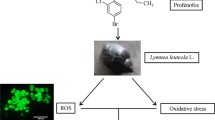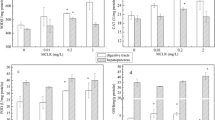Abstract
Ethylbenzene is classified as a priority pollutant; however, toxicity data, especially those regarding sublethal toxicity, are rarely reported on gastropods. The present work was performed to elucidate the sublethal effects of ethylbenzene using a freshwater snail, Bellamya aeruginosa (Reeve), exposed to ethylbenzene for 21 days followed by a 17-day recovery period. Superoxide dismutase (SOD), catalase (CAT), glutathione S-transferase (GST), reduced glutathione (GSH), and malonyldialdehyde (MDA) were used as biomarkers to evaluate oxidative stress in hepatopancreas of snails. In addition, alkaline comet assay was applied to determine the genotoxicity of ethylbenzene in hepatopancreas of snails. These biomarkers and DNA damage exhibited various responses to ethylbenzene in the tested snails. SOD and CAT activities were almost significantly stimulated during the exposure period. As exposure time was prolonged beyond 7 days, CAT activity gradually became significantly increased at higher doses of ethylbenzene. GSH concentration was positively and linearly related with exposure dose. MDA concentration was significantly greater than that in the control only under the lowest treatment after a 7-day exposure. Alkaline comet assay showed that ethylbenzene could significantly induce DNA damage in hepatopancreas of snails, and there was a good dose- and time-response in DNA damage, indicating potential genotoxicity of ethylbenzene on snails. At the end of the recovery period, the repair of DNA damage was not yet completed, showing that DNA repair requires more time. The findings from this study could indicate that SOD, GST, and GSH seem to be effective oxidative biomarkers for snails exposed to ethylbenzene in the short term. CAT proved to be a valuable discriminating biomarker in subchronic exposure to ethylbenzene, but MDA was not a suitable oxidative biomarker for exposure to ethylbenzene in either the short or long term. Alkaline comet assay was efficient tool with which to evaluate the potential genotoxicity of ethylbenzene.






Similar content being viewed by others
References
Aebi H (1984) Catalase in vitro. Methods Enzymol 105:121–126
Agency for Toxic Substances and Disease Registry (1999) Toxicological profile for ethylbenzene. Public Health Service, United States Department of Health and Human Services
Ahmed RG (2005) Is there a balance between oxidative stress and antioxidant defence system during development. Med J Islam Acad Sci 15:255–263
Akcha F, Izuel C, Venier P, Budzinski H, Burgeot T, Narbonne JF (2000) Enzymatic biomarker measurement and study of DNA adduct formation in benzo[a]pyrene-contaminated mussels, Mytilus galloprovincialis. Aquat Toxicol 49:269–287
Aloísio M, Pires C, Gáspari C, Massuti M, Neves C, Curi-Pedrosa R et al (2002) Oxidative stress in the mussel Mytella guyanensis from polluted mangroves on Santa Catarina Island, Brazil. Mar Pollut Bull 44:923–932
Asagba SO, Eriyamremu GE, Igberaese ME (2008) Bioaccumulation of cadmium and its biochemical effect on selected tissues of the catfish (Clarias gariepinus). Fish Physiol Biochem 34:61–69
Boyne AF, Ellman GL (1972) A methodology for analysis of tissue sulfhydryl components. Anal Biochem 46:639–653
Bradford MM (1976) A rapid and sensitive method for the quantitation of microgram quantities of protein utilizing the principle of protein-dye binding. Anal Biochem 72:248–254
Cao L, Huang W, Liu JH, Yin XB, Dou SZ (2010) Accumulation and oxidative stress biomarkers in Japanese flounder larvae and juveniles under chronic cadmium exposure. Comp Biochem Physiol C Toxicol Pharmacol 151:386–392
Cunha I, Mangas-Ramirez E, Guilhermino L (2007) Effects of copper and cadmium on cholinesterase and glutathione S-transferase activities of two marine gastropoda (Monodonta lineate and Nucella lapillus). Comp Biochem Physiol C Toxicol Pharmacol 145:648–657
Dórea HS, Bispo JRL, Aragão KAS, Cunha BB, Navickiene S, Alves JPH et al (2007) Analysis of BTEX, PAHs and metals in the oilfield produced water in the state of Sergipe, Brazil. Microchem J 85:234–238
Downs CA, Shigenaka G, Fauth JE, Robinson CE, Huang A (2002) Cellular physiological assessment of bivalves after chronic exposure to spilled Exxon Valdez crude oil using a novel molecular diagnostic biotechnology. Environ Sci Technol 36:2987–2993
Doyotte A, Cossu C, Jacquin MC, Babut M, Vasseur P (1997) Antioxidants enzymes, glutathione and lipid peroxidation as relevant biomarkers of experimental or field exposure in the gills and the digestive gland of the fresh water bivalve Unio tumidus. Aquat Toxicol 39:93–110
Fournier D, Bride JM, Poirie M, Berge JB, Plapp FW (1992) Insect glutathione S-transferases: biochemical characteristics of the major forms of houseflies susceptible and resistant to insecticides. J Biol Chem 267:1840–1845
Gowland BTG, McIntosh AD, Davies IM, Moffat CF, Webster L (2002) Implications from a field study regarding the relationship between polycyclic aromatic hydrocarbons and glutathione S-transferase activity in mussels. Mar Environ Res 54:231–235
Habig WH, Jakoby WB (1981) Assays for the differentiation of glutathione S-transferases. Methods Enzymol 77:398–405
Hiroshi O, Nobuko O, Kunio Y (1979) Assay for lipid peroxides in animal tissues by thiobarbituric acid reaction. Anal Biochem 95:351–358
Hook SE, Lee RF (2004) Genotoxicant induced DNA damage and repair in early and late developmental stages of the grass shrimp Paleomonetes pugio embryo as measured by the comet assay. Aquat Toxicol 66:1–14
Huybrechts T, Dewulf J, Langenhove HV (2004) Spatial and temporal variability of priority volatile organic compounds in the Scheldt estuary. Water Res 38:3241–3250
Izawa S, Inoue Y, Kimura A (1996) Importance of catalase in the adaptive response to hydrogen peroxide: analysis of acatalasaemic Saccharomyces cerevisiae. Biochem J 320:61–67
Jha Awadhesh N (2008) Ecotoxicological applications and significance of the comet assay. Mutagenesis 23:207–221
Kappus H (1985) Lipid peroxidation: Mechanisms, analysis, enzymology and biological relevance. In: Sies H (ed) Oxidative stress. Academic, London, pp 273–310
Kelley CA, Hammer BT (1997) Concentrations stable isotope values of BTEX in gasoline-contaminated groundwater. Environ Sci Technol 31:2469–2472
Kidd PM (1997) Glutathione: systemic protectant against oxidative and free radical damage. Alt Med Rev 2:155–176
Laffon B, Aldao I, Pérez-Cadahía B, Pásaro E, Méndez J (2006) First step in the evaluation of the effects of Prestige oil on the shore environment: availability, bioaccumulation and DNA damage. Cienc Mar 32:389–399
Liu Y, Zhou QX, Xie XJ, Lin DS, Dong LX (2010) Oxidative stress and DNA damage in the earthworm Eisenia fetida induced by toluene, ethylbenzene and xylene. Ecotoxicology 19:1551–1559
Livingstone DR (2001) Contaminant-stimulated reactive oxygen species production and oxidative damage in aquatic organisms. Mar Pollut Bull 42:656–666
Livingstone DR (2003) Oxidative stress in aquatic organisms in relation to pollution and aquaculture. Rev Med Vet 154:427–430
Lu KH, Zhang SL, Zhang CJ, Xie LF, Liang JJ (2010) Detection of DNA damage in liver cells of Bellamya aeruginosa induced by microcystins with comet assay. J Agroenviron Sci 29:1079–1085 [in Chinese]
Ma TW, Gong SJ, Zhou K, Zhu C, Deng KD, Luo QH et al (2010) Laboratory culture of the freshwater benthic gastropod Bellamya aeruginosa (Reeve) and its utility as a test species for sediment toxicity. J Environ Sci 22:304–313
Marklund S, Marklund G (1974) Involvement of superoxide anion radical in the autoxidation of pyrogallol and a convenient assay for superoxide dismutase. Eur J Biochem 47:469–474
Marnett LJ (2000) Oxyradicals and DNA damage. Carcinogenesis 21:361–370
McFarland VA, Inouye LS, Lutz CH, Jarvis AS, Clarke JU, McCant DD (1999) Biomarkers of oxidative stress and genotoxicity in livers of field-collected brown bullhead, Ameiurus nebulosus. Arch Environ Contam Toxicol 37:236–241
Midorikawa K, Uchida T, Okamoto Y, Toda C, Sakai Y, Ueda K et al (2004) Metabolic activation of carcinogenic ethylbenzene leads to oxidative DNA damage. Chem Biol Interact 150:271–281
Moreira SM, Moreira-Santos M, Ribeiro R, Guilhermino L (2004) The “coral bulker” fuel oil spill on the north coast of Portugal: spatial and temporal biomarker responses in Mytilus galloprovincialis. Ecotoxicology 13:619–630
Organization for Economic Co-operation and Development (2002) SIDS (Screening Information Data Set) assessment report for Ethylbenzene
Reed DJ, Beatty PW (1980) Biosynthesis and regulation of glutathione: toxicological implications. Rev Biochem Toxicol 2:213–241
Schmidt TC, Haderlein SB, Pfister R, Forster R (2004) Occurrence and fate modeling of MTBE and BTEX compounds in a Swiss Lake used as drinking water supply. Water Res 38:1520–1529
Sen CK, Marin E, Kretzschmar M, Hanninen O (1992) Skeletal muscle and liver glutathione homeostasis in response to training, exercise and immobilization. J Appl Physiol 73:1265–1272
Singh NP, MoCoy MT, Tice RR, Schneider EL (1988) A simple technique for quantitation of low levels of DNA damage in individual cells. Exp Cell Res 175:184–191
Sun Y, Yin G, Zhang J, Yu H, Wang X (2007) Bioaccumulation and ROS generation in liver of freshwater fish, goldfish Carassius auratus under HC Orange No. 1 exposure. Environ Toxicol 22:256–263
Vanzella TP, Martinez CBR, Cólus IMS (2007) Genotoxic and mutagenic effects of diesel oil water soluble fraction on a neotropical fish species. Mutat Res 631:36–43
Wu JF, Yu ZM, Song XX, Wang Y (2006) Response of integrated biomarkers of fish (Lateolabrax japonicus) exposed to benzo[a]pyrene and sodium dodecylbenzene sulfonate. Ecotoxicol Environ Saf 65:230–236
Yan S, Zhou QX (2011) Toxic effects of Hydrilla verticillata exposed to toluene, ethylbenzene and xylene and safety assessment for protecting aquatic macrophytes. Chemosphere 85:1088–1094
Zhang YS, Andersson T, Forlin L (1990) Induction of hepatic xenobiotic biotransformation enzymes in rainbow trout by ß-naphthoflavone. Time-course studies. Comp Biochem Physiol B 95:247–253
Zhang JF, Liu H, Sun YY, Wang XR, Wu JC, Xue YQ (2005) Responses of the antioxidant defenses of the Goldfish Carassius auratus, exposed to 2,4-dichlorophenol. Environ Toxicol Pharm 19:185–190
Zhou QX, Kong FX, Zhu L (2004) Ecotoxicology. Science Press, Beijing [in Chinese]
Acknowledgments
This work was financially supported by the Ministry of Environmental Protection, People’s Republic of China, as a commonwealth project (Grant No. 200909041) and by the National Natural Science Foundation of China as a key project (Grant No. 21037002).
Author information
Authors and Affiliations
Corresponding author
Rights and permissions
About this article
Cite this article
Zheng, S., Wang, Y., Zhou, Q. et al. Responses of Oxidative Stress Biomarkers and DNA Damage on a Freshwater Snail (Bellamya aeruginosa) Stressed by Ethylbenzene. Arch Environ Contam Toxicol 65, 251–259 (2013). https://doi.org/10.1007/s00244-013-9899-z
Received:
Accepted:
Published:
Issue Date:
DOI: https://doi.org/10.1007/s00244-013-9899-z




